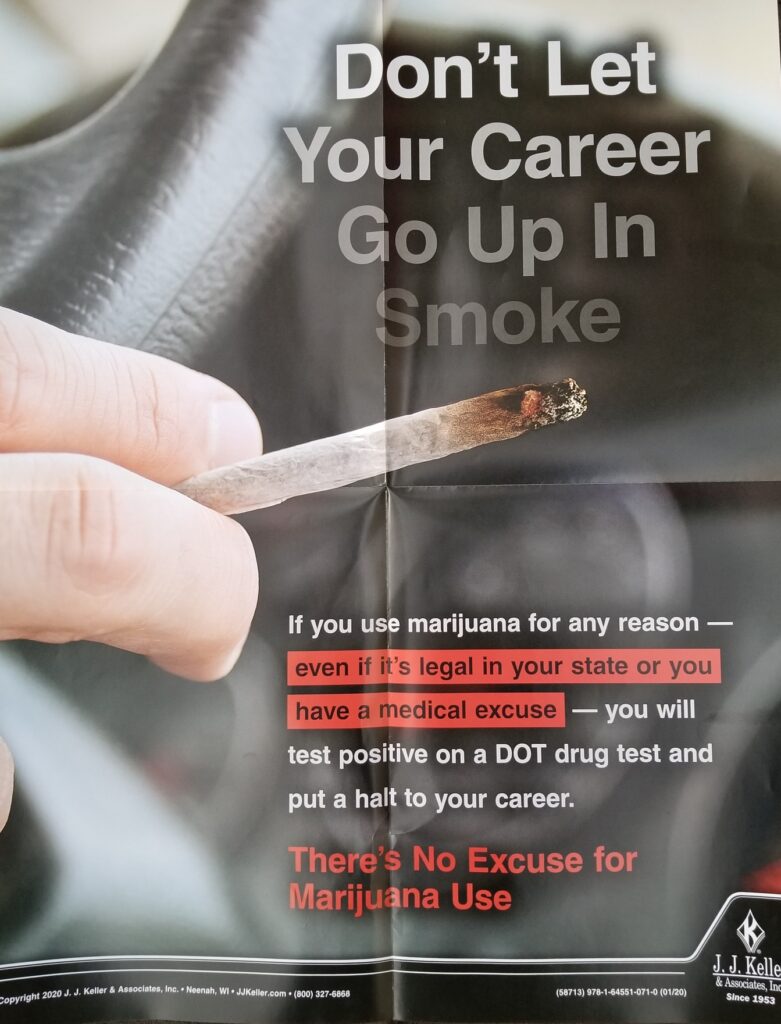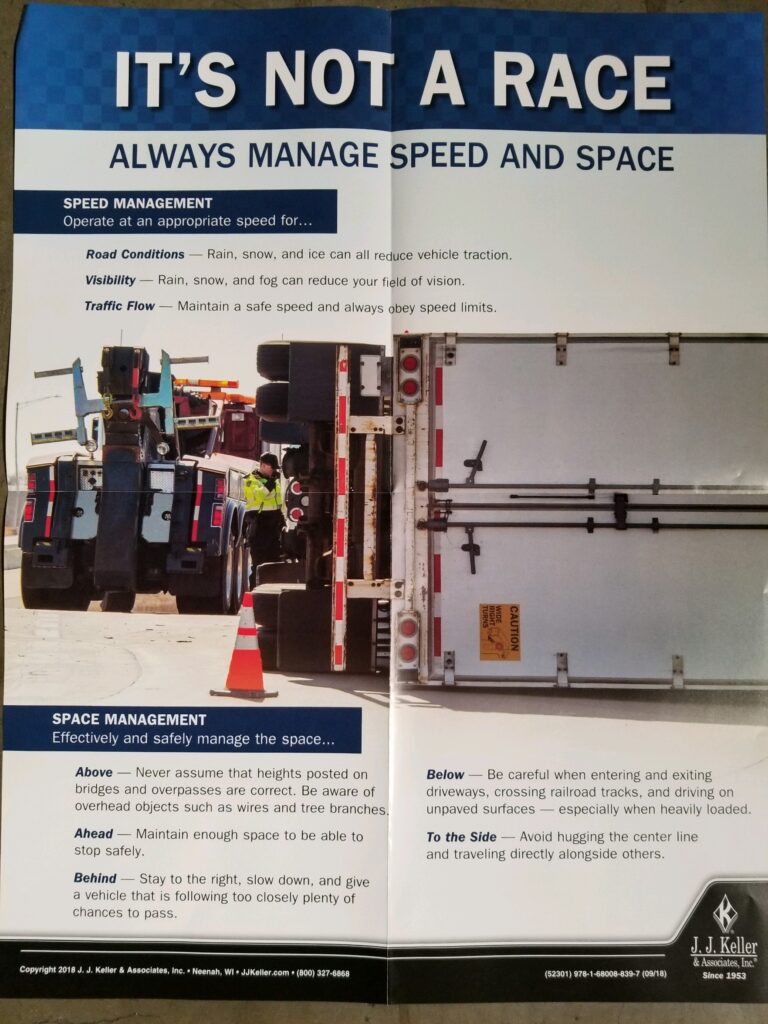Monthly Safety Topic: Can Other Drivers See you?

Monthly Safety Topic: Three Deadly sins of Truck Driving

Monthly Safety Topic: Hours Of Service

Monthly Safety Topic: Lifting

Monthly Safety Topic: Accidents

Monthly Safety Topic: Hours Of Service

Monthly Safety Topic: Marijuana

Monthly Safety Topic: Defensive Driving
A defensive driver
- Observes the entire situation
- Watches for changes
- Recognizes potential hazards
- Decides on the appropriate response
- Carries out the plan
Continually scan the entire area looking 12 to 15 seconds ahead and watch for anything that could affect your patch of travel
Use your mirrors and side windows to scan to the sides
Use your mirrors to monitor the back of your vehicle for potential hazards and tire problems.

Monthly Safety Topic: Summer Driving
Be A Defensive Driver This Summer
- Signs of a tourist
- Over-packed vehicles
- Car-top carriers
- Vehicles towing boats, campers, trailers
- Slow moving vehicles
- Frequent braking
- Vehicles changing direction without warning
- Drivers looking at signs or maps
- Out of state license plates
- Dealing with impaired drivers
- Allow for plenty of following distance or exit the roadway
- Contact law enforcement
- Use caution in construction zones
- Pay attention
- Don’t tailgate
- Don’t speed
- Merge as soon as possible
- Always expect the unexpected

Monthly Safety Topic: Work Zone Safety
Driver Safely In Work Zones
- Pay attention to the signs
- Orange, diamond shaped signs are posted ahead of work zones to give advance warning of lane closings, speed reductions, and workers ahead.
- Plan ahead
- A driver should keep up with the latest road conditions. Many states maintain websites that keep drivers current with the latest road conditions.
- Use the lane furthest from the work zone
- Doing this when possible provides additional space between sides of a vehicle and construction workers.
- Get into the correct lane well in advance of lane closures
- It is easier and safer to make a lane change well in advance than when arriving at a lane closure.
- Be aware of your vehicle’s blind spots
- Vehicles may be hidden in a commercial motor vehicle’s “No Zone”. A driver should not change lanes in a work zone unless absolutely necessary and should avoid sudden lane changes.
- Slow down – obey posted speed limits
- These reduced speeds are for everyone’s safety.
- Maintain a safe following distance
- One of the most cited factors in work zone related crashes is speed. In a work zone, there’s less time and room to react to a sudden change in driving conditions.
- Be prepared to slow down or stop
- A driver’s undivided attention should be on the road ahead of them.
- Watch for workers on or near the road
- Workers may be entering or crossing traffic lanes – often at a speed slower than the flow of traffic.
- Be patient
- A driver should slow down and pay attention to surroundings.
- Use additional caution at night
- Enough time should be scheduled to make the trip, or (if possible) an alternate route should be taken.
ALWAYS EXPECT THE UNEXPECTED

Monthly Safety Topic: Warning Devices
If your vehicle is stopped on the traveled portion or the shoulder of the highway, you must:
– Activate your vehicle’s four-way flashers
– Within ten minutes, set out warning devices
On two-lane roads, place one device:
– On the traffic side of the vehicle, 10 feet from the vehicle’s front or rear (depending on direction) and
– Behind the vehicle by 100 feet and
– Ahead of the vehicle by 100 feet
One one-way or divided highways:
– Place devices 10 feet, 100 feet, and 200 feet from the rear of the vehicle facing approaching traffic
Within 500 feet of a hill/curve/obstruction, place:
– One device 100 feet to 500 feet from the vehicle in the direction of the obstruction
– The other two devices according to the rules for a two-lane or divided highway

Monthly Safety Topic: Fire Safety
Cab Engine:
– Maintain a clean and trash-free cab
– Immediately wipe up any oil or fluid spills
– Regularly check:
– Wiring/electrical system
– Fuses
– Battery
– Exhaust System
Tires/Brakes:
– Make sure tires are properly inflated
– Change flat/soft tires as soon as possible
– Never put a hot tire in the spare rack
– Check brakes – worn brakes can overheat
– All brakes must be fully released before moving
Cargo:
– Check mirrors for smoke
– Know what type (s) of cargo you are hauling
– Never smoke when:
– Hauling hazardous materials
– Loading/unloading your vehicle

Monthly Safety Topic: Speed and Space Management
Manage Speed
- Operate at an appropriate speed for road conditions, visibility, traffic speed/flow
Manage Space
- Ahead
- Allow at least one second for each 10 feet of vehicle length at speeds below 40 mph
- At greater speeds, add an additional second
- Allow for a greater stopping distance in poor weather
- Behind
- Signal earl, gradually reduce speed when turning or changing lanes, increase following distance
- To the sides
- Don’t hug the center line
- Avoid hugging the right side of the road
- Avoid traveling alongside other vehicles
- Above
- Never assume posted heights on bridges and overpasses are correct
- When in doubt about overhead space, take another route
- Below
- Be careful on railroad tracks, driveways, dirt roads
- Make sure landing gear is raised

Monthly Safety Topic: School Bus Safety
Use Your Defensive Skills:
– Continually scan the road
– Obey the posted speed limit
– Reduce speed as necessary
– Pay extra attention in school zones and at bus stops
– Watch for children at bus stops and walking in the road
When Approaching A School Bus:
– Slow down
– Be aware of children approaching and leaving a school bus
– Never pass a school bus on the right side
– Prepare to stop when the yellow lights are flashing on a school bus
– Never pass a school bus when its lights are flashing and its stop arm is extended
ALWAYS…expect the unexpected

Monthly Safety Topic: Dock and warehouse safety
When exiting your vehicle:
– Use the “three-point” rule
– Never jump
– Watch for slipping and falling hazards
At the loading docks:
– Set the parking brake
– Turn off the vehicle
– Put your vehicle’s keys in your pocket
– Chock the wheels
– When opening the trailer door, watch for falling freight
– Everyone must use the same hand signals, light systems, signs
– Never leave the dock until you get an “all clear” signal

Monthly Safety Topic: Slips, Trips, and Falls
When entering or exiting your vehicle:
– Face your vehicle
– Follow the three-point rule (always have 3 limbs in contact with your vehicle)
– Never jump
– Your hands should be free (don’t try to carry something)
When at load docks:
– Be aware of your surroundings
– Use handrails and grips
– Never run up or down stairs
– Take short steps on slippery or smooth surfaces
– Do not carry items you cannot see over

